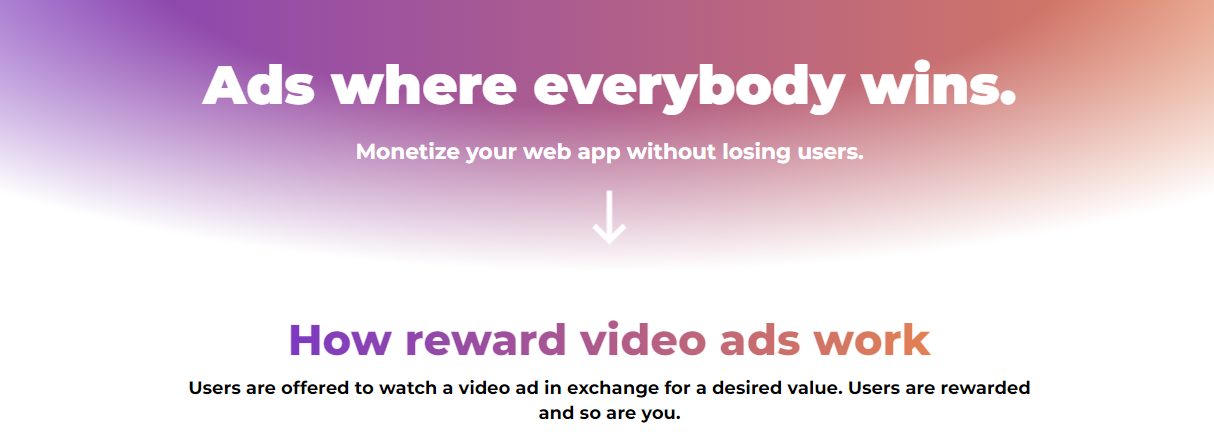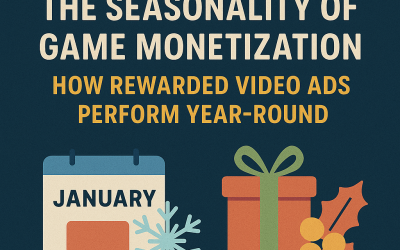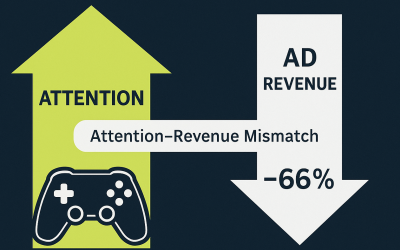The Latest Trends in Web Monetization: 2024 and Beyond
As the digital landscape evolves, so do strategies for monetizing websites. Today, advertisers and publishers are exploring innovative web monetization trends that cater to user experience, drive higher engagement, and generate sustainable revenue. Let’s delve into the latest trends shaping the web monetization industry and how you can leverage them to maximize earnings in 2024 and beyond.
[ez-toc]
-
Contents
- 1 Rewarded Ads for Websites: Engaging Users for Higher Returns
- 2 Rise of Content Monetization Platforms
- 3 Contextual Advertising: Privacy-First and Relevant
- 4 Video Monetization Platforms and Interactive Video Ads
- 5 Paywalls and Freemium Models for Exclusive Content
- 6 Programmatic Advertising and AI-Driven Ad Optimization
- 7 Web Monetization for WebGL and Gaming Content
- 8 Ad Revenue Calculators and Advanced Analytics Tools
- 9 Native Ads: Seamless User Experience
Rewarded Ads for Websites: Engaging Users for Higher Returns
Rewarded ads, traditionally associated with mobile gaming, are making their way onto websites. This model, where users receive a reward (like exclusive content, discounts, or credits) for watching an ad, has gained traction as it aligns well with users’ expectations. Rewarded ads can enhance user experience by making ad interactions optional and incentivized, which leads to higher engagement and satisfaction. Publishers benefit from better ad completion rates and increased revenue, while users enjoy an ad experience they control.
Why It’s Trending:
- Increased Engagement: Rewarded ads keep users on-site longer, improving metrics like bounce rate and average session duration.
- User Satisfaction: Since these ads are optional, users tend to have a more positive view of the ads they engage with.
- Revenue Boost: High completion rates drive better CPM (cost per thousand impressions) and eCPM (effective cost per thousand impressions) for publishers.
-
Rise of Content Monetization Platforms
![]() Content monetization platforms, such as Patreon, Substack, and Ko-fi, have gained popularity as they empower creators to earn directly from their audience. With more people willing to pay for valuable, ad-free content, creators are finding new ways to offer exclusive content, tutorials, and courses. This trend benefits smaller websites or individual creators who may not have the same ad revenue potential as larger sites but can build a loyal subscriber base for steady income.
Content monetization platforms, such as Patreon, Substack, and Ko-fi, have gained popularity as they empower creators to earn directly from their audience. With more people willing to pay for valuable, ad-free content, creators are finding new ways to offer exclusive content, tutorials, and courses. This trend benefits smaller websites or individual creators who may not have the same ad revenue potential as larger sites but can build a loyal subscriber base for steady income.
Why It’s Trending:
- Direct-to-Fan Monetization: Content creators receive direct support from their audience, creating sustainable revenue streams.
- Reduced Ad Reliance: As users embrace subscription models, sites can reduce ad reliance, creating a cleaner experience.
- Diverse Offerings: Sites can monetize through memberships, exclusive content, live events, and merchandise sales.
-
Contextual Advertising: Privacy-First and Relevant
With privacy concerns on the rise, contextual advertising has emerged as a robust alternative to cookie-based targeting. Contextual ads display ads based on the content of the page rather than user data, making it more privacy-friendly. For example, a sports blog may feature ads for athletic wear without tracking the user’s personal browsing history.
Why It’s Trending:
- Privacy Compliance: Contextual ads align well with GDPR and CCPA guidelines, respecting user privacy.
- User Experience: Users tend to respond better to ads that feel naturally integrated with the content.
- Resilience Against Cookie Restrictions: As third-party cookies become obsolete, contextual advertising remains effective.
-
Video Monetization Platforms and Interactive Video Ads
Video continues to dominate the digital space, with consumption rates skyrocketing across all demographics. Video monetization platforms now offer interactive video ads, where viewers can engage directly with the content. These ads might allow users to choose their storyline or interact with products within the video. Interactive videos increase engagement, making users more likely to remember the brand and complete the CTA.
Why It’s Trending:
- Higher Engagement Rates: Interactive ads see better engagement as users are more invested in the content.
- Better Recall: Interactive video ads are often more memorable, translating into better conversion rates.
- Premium CPMs: Video ads command higher CPMs, and the interactive element further boosts eCPM, benefiting publishers.
-
Paywalls and Freemium Models for Exclusive Content
More websites are implementing paywalls and freemium models, allowing free access to basic content while locking premium content behind a paywall. This approach is especially popular with news sites, streaming services, and digital publications. Freemium models offer a taste of what users can expect in the premium section, enticing them to upgrade for full access.
Why It’s Trending:
- Diversified Revenue: Instead of relying solely on ads, publishers can monetize through subscriptions.
- Loyal User Base: Paid users are more likely to be loyal, returning to the site regularly.
- Sustainable Growth: Subscription models offer a predictable revenue stream, especially as ad rates fluctuate.
-
Programmatic Advertising and AI-Driven Ad Optimization
AI in programmatic advertising is a game-changer for web monetization. AI algorithms optimize ad placements in real-time, delivering ads that match user behavior and page context while maximizing ad revenue. For instance, AI can predict which ad types perform best during certain times, adapting ad displays accordingly.
Why It’s Trending:
- Improved Efficiency: AI-powered programmatic ads reduce manual effort and enhance ad targeting precision.
- Revenue Optimization: Dynamic adjustments based on real-time data increase CPM and fill rates.
- Enhanced User Experience: Users see ads that are more relevant, reducing ad fatigue and improving overall site engagement.
-
Web Monetization for WebGL and Gaming Content
WebGL-based games are gaining popularity, offering immersive experiences directly in web browsers. The potential for in-game advertising and rewarded video ads within these games is substantial. By implementing rewarded ads, game developers on the web can monetize while maintaining user experience. Additionally, WebGL makes it easier to integrate ad networks and SDKs that offer in-game ad placements without needing a standalone app.
![]() Why It’s Trending:
Why It’s Trending:
- Increased Engagement: WebGL games provide immersive experiences, increasing user session times.
- Ad Monetization Potential: WebGL supports both rewarded and in-game ads, making it easier to monetize effectively.
- Growth in Browser-Based Games: Browser games are seeing a resurgence, making WebGL a profitable space for ads.
-
Ad Revenue Calculators and Advanced Analytics Tools
Publishers increasingly rely on ad revenue calculators and analytics tools to understand revenue metrics like CPM, ARPDAU (Average Revenue per Daily Active User), and LTV (Lifetime Value). These tools empower publishers to make informed decisions and optimize strategies for ad placements, demand-side platforms, and user segmentation.
Why It’s Trending:
- Data-Driven Decisions: Publishers can evaluate ad placements based on real-time analytics, maximizing revenue.
- Better Forecasting: Revenue calculators help in projecting potential earnings, aiding in strategic planning.
- Enhanced Personalization: Analytics enable segmented ad experiences, leading to improved engagement and revenue.
-
Native Ads: Seamless User Experience
Native ads, designed to match the look and feel of the surrounding content, continue to be a strong trend in web monetization. These ads blend seamlessly into the content, appearing less intrusive to users while delivering higher click-through rates. Native ads are ideal for blogs, news sites, and content-heavy websites that aim to maintain a cohesive user experience without sacrificing ad revenue.
Why It’s Trending:
- Higher Engagement: Native ads perform better in terms of engagement and user interaction.
- Subtle Integration: They fit naturally within content, maintaining a pleasant user experience.
- Revenue Potential: Native ads tend to generate higher click-through rates, increasing eCPM.
Final Thoughts
As we move further into 2024, the focus in web monetization is shifting towards user-friendly, privacy-compliant, and interactive approaches that generate revenue without compromising on experience. Publishers are finding that a diversified monetization strategy — combining rewarded ads, contextual ads, and premium content models — helps reduce dependency on any single revenue stream, ultimately creating a more sustainable business model.
By adopting these trends, publishers can create a dynamic and profitable website that meets modern users’ expectations and remains agile in a rapidly changing digital landscape.



